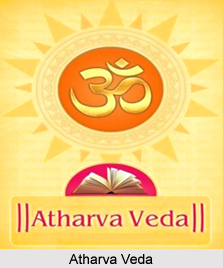 In the Atharva Veda, there are found a number of spells for restoration as it is believed that all evil, such as family discord, was due to the influence of evil demons or malicious demons. It is due to the discord created by these demons that there are found in the Atharva Veda for the restoration of harmony. These spells stand midway between expiatory formula and the benedictions. To this class of spells belong not only the spells by which peace and harmony are to restored within a family but also a number of formulas by which one can appease the wrath of a great master. Also found within this category are spells by means of which one can achieve one`s desires to gain influence an assembly, the art of persuasion in a court of law, and so on. Some of the spells are also reconciliatory in nature and can also be employed in the restoration of unity between the husband and the wife.
In the Atharva Veda, there are found a number of spells for restoration as it is believed that all evil, such as family discord, was due to the influence of evil demons or malicious demons. It is due to the discord created by these demons that there are found in the Atharva Veda for the restoration of harmony. These spells stand midway between expiatory formula and the benedictions. To this class of spells belong not only the spells by which peace and harmony are to restored within a family but also a number of formulas by which one can appease the wrath of a great master. Also found within this category are spells by means of which one can achieve one`s desires to gain influence an assembly, the art of persuasion in a court of law, and so on. Some of the spells are also reconciliatory in nature and can also be employed in the restoration of unity between the husband and the wife.
The magic songs referring to marriage and love form a large separate class of hymns of the Atharva Veda. In the Kaushika Sutra one becomes acquainted with the manifold kinds of love-magic and all the magic rites, which are called "Strikarmani" or women`s rites, and for which these songs and spells were employed. There are, however, two sort of spells belonging to this class. Those of the one kind have a sociable and peaceful character and refer to marriage and the begetting of children. They are pious spells connected with harmless magical rites by which a maiden tries to obtain a bridegroom, or a young man, a bride, benedictions upon the bridal pair and the newly-married, magic songs and spells through which conception shall be accelerated and the birth of a male child effected, prayers for protection of the pregnant woman, also of the unborn and the new-born child, and so on. Of this kind is the whole of Book XIV, which contains a collection of marriage-verses and is, on the whole, a second, greatly enlarged edition of the marriage verses of the Rig Veda.
More numerous is the second kind of these spells, consisting of wild exorcisms and curses, which refer to love-intrigues and disturbances of the married life. Still fairly harmless are the spells through which a wife wishes to pacify her husband`s jealousy, or the verses which are to bring the unfaithful wife back to her husband, or the charm for inducing sleep.
Less harmless and partly of primeval savageness are the spells by which a person is to be forced to love against his or her will. The belief, existing all over the world, that by means of the picture of a person one can harm or obtain power over that person, is also found in ancient India. If a man wished to gain the love of a woman, he made a picture out of clay, took a bow with a string of hemp, an arrow the barb of which was a thorn, the feather of which came from an owl, the shaft of which was made of black wood, and began to pierce the heart of the picture through and through with the arrow-a symbolical piercing of the heart of the beloved with the arrow of the love-god Kama-while he recited the verses of the magic song contained in the Atharva Veda. A woman acts in a similar manner if she wants to compel the love of a man. She makes an effigy of the man, places it before herself, and hurls heated arrow-heads at it, while she recites the appropriate song from the Veda. The wildest incantations, actually bristling with hatred are those which women use in the attempt to oust their rivals.
These are the focal issues dealt with in the prayers for restoration of harmony within families and relationships.













